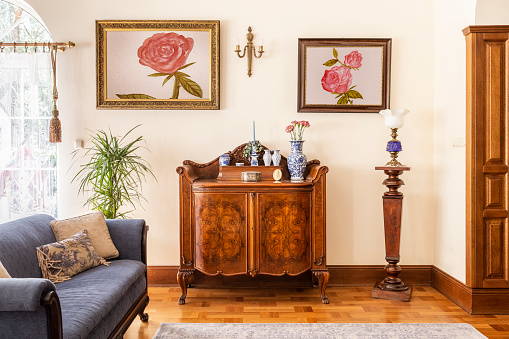
Antique and vintage wood furniture holds a certain allure that captivates the imagination. These pieces, steeped in history and craftsmanship, bring a unique charm and character to any space. Whether it’s an ornate Victorian chest of drawers or a sleek mid-century modern coffee table, these treasures from the past have the power to transform interiors and evoke a sense of nostalgia. In this article, we will delve into the world of antique and vintage wood furniture, exploring the distinguishing features of each, understanding their historical significance, learning how to identify authentic pieces, and discovering the joy of collecting and integrating them into modern interiors.
Understanding Antique and Vintage Furniture
Before embarking on a journey into the realm of antique and vintage wood furniture, it is important to distinguish between the two categories. Antique furniture refers to pieces that are typically more than 100 years old, while vintage furniture typically refers to items from the mid-20th century, between 30 to 100 years old. These pieces offer glimpses into different historical periods, showcasing unique styles and design elements that have stood the test of time.
Identifying and Evaluating Authentic Pieces
Authenticity is paramount when it comes to antique and vintage furniture. To ensure you’re investing in genuine pieces, it is essential to understand the telltale signs of age, craftsmanship, and quality. Examining the construction techniques, materials used, and the presence of appropriate markings or labels can provide valuable insights. Additionally, exploring the provenance and documentation of a piece can offer further validation of its authenticity and historical value.
Popular Antique Furniture Styles
Antique furniture encompasses an array of styles, each with its own distinct characteristics and historical contexts. From the ornate elegance of Victorian furniture to the timeless grace of Georgian designs, these styles reflect the prevailing tastes and aesthetics of their respective periods. By understanding the key features and materials associated with each style, collectors can appreciate the nuances that make each piece truly unique.
Vintage Furniture: Design Movements and Styles
In the mid-20th century, design movements and styles emerged that continue to influence contemporary aesthetics. Art Deco captivated with its geometric forms and luxurious materials, while the clean lines and organic shapes of Mid-Century Modern pieces became icons of modern design. Exploring these vintage styles allows us to appreciate the innovative spirit and design philosophies that defined these eras.
Restoration and Preservation
When acquiring antique and vintage furniture, restoration and preservation become essential considerations. These pieces have weathered the test of time, and it is our responsibility to ensure their continued longevity. Proper cleaning, repair, and refinishing techniques are vital, but it is equally important to strike a balance between restoration and preserving the original patina and character that make these pieces truly special.
Collecting Antique and Vintage Furniture
Starting an antique or vintage furniture collection can be a fulfilling journey, but it requires careful consideration and research. Factors such as condition, rarity, and market trends play significant roles in determining the value and desirability of a piece. Exploring reputable dealers, auctions, and online platforms can provide opportunities to discover hidden gems and connect with fellow enthusiasts.
Caring for Antique and Vintage Furniture
Owning antique and vintage furniture comes with the responsibility of proper care and maintenance. Implementing precautions against pests, controlling humidity levels, and regular cleaning routines are essential to ensure the longevity of these pieces. Additionally, consulting professional conservation services can offer expertise and guidance for more complex restoration projects.
Incorporating Antique and Vintage Furniture in Modern Interiors
Antique and vintage furniture has the remarkable ability to seamlessly blend with modern interiors, creating captivating juxtapositions that infuse spaces with character and warmth. Integrating these pieces into contemporary settings allows for a unique design narrative that bridges the gap between the past and the present. Mixing old and new can create a visually stimulating and eclectic environment that showcases personal style and appreciation for craftsmanship.
By carefully selecting antique and vintage furniture, you can add a focal point or conversation starter to your modern space. A well-placed Victorian armchair in a minimalist living room can add a touch of elegance and sophistication, while a mid-century modern sideboard in a sleek dining area can bring a sense of nostalgia and nostalgia. The key is to strike a balance between the different elements, ensuring that each piece complements the overall aesthetic while maintaining its individuality.
When incorporating antique and vintage furniture, it’s essential to consider the scale and proportion of the pieces in relation to the surrounding space. Mixing styles and materials can create a harmonious blend that adds visual interest and depth to the design. For instance, pairing a rustic farmhouse table with contemporary metal chairs can create a captivating contrast that highlights the unique characteristics of each piece.
Accessories and decor play a crucial role in tying together antique and vintage furniture with modern interiors. Choosing complementary lighting fixtures, textiles, and artwork can enhance the overall ambiance and create a cohesive design story. For example, adorning an antique wooden dresser with contemporary art pieces and accentuating it with modern lighting can create a captivating fusion of old and new.
Additionally, embracing the imperfections and patina of antique and vintage furniture can enhance their charm. Scuffs, scratches, and signs of age tell stories and add authenticity to the pieces. Rather than attempting to erase these marks, celebrate them as part of the furniture’s history and character.
Conclusion
In conclusion, antique and vintage wood furniture holds a timeless beauty and a sense of history that captivates collectors and design enthusiasts alike. Understanding the distinction between antique and vintage pieces, identifying authentic items, and appreciating the different furniture styles and design movements allow for a deeper connection with these treasures from the past. Whether you choose to collect antique furniture as a hobby or incorporate vintage pieces into your modern interiors, these furniture pieces offer a tangible link to bygone eras, allowing us to celebrate craftsmanship, individuality, and the enduring appeal of wood furniture throughout history.
By thoughtfully integrating antique and vintage wood furniture into modern spaces, we create a narrative that celebrates both the past and the present. Embracing the unique qualities of these pieces and showcasing them alongside contemporary elements can result in captivating and eclectic interiors that tell stories and evoke a sense of nostalgia. So, as you embark on your journey of exploring antique and vintage wood furniture, allow yourself to be enchanted by the stories they hold and the timeless beauty they bring to your home.


